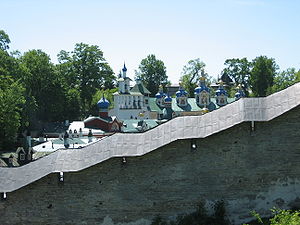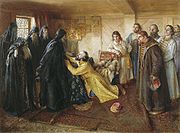
Pskovo-Pechorsky Monastery
Encyclopedia

Russian Orthodox Church
The Russian Orthodox Church or, alternatively, the Moscow Patriarchate The ROC is often said to be the largest of the Eastern Orthodox churches in the world; including all the autocephalous churches under its umbrella, its adherents number over 150 million worldwide—about half of the 300 million...
male monastery
Monastery
Monastery denotes the building, or complex of buildings, that houses a room reserved for prayer as well as the domestic quarters and workplace of monastics, whether monks or nuns, and whether living in community or alone .Monasteries may vary greatly in size – a small dwelling accommodating only...
, located in Pechory
Pechory
Pechory : Petseri; ) is a town and the administrative center of Pechorsky District of Pskov Oblast, Russia. Population: The population includes a few hundred ethnic Estonians.The town is famous for the Russian Orthodox Pskovo-Pechersky Monastery....
, Pskov Oblast
Pskov Oblast
Pskov Oblast is a federal subject of Russia . Pskov Oblast borders the countries of Estonia and Latvia, as well as Belarus. It is the westernmost federal subject of contiguous Russia . Its major cities are the administrative center Pskov and Velikiye Luki . Area: 55,300 km²...
in Russia
Russia
Russia or , officially known as both Russia and the Russian Federation , is a country in northern Eurasia. It is a federal semi-presidential republic, comprising 83 federal subjects...
, just a few kilometers from the Estonia
Estonia
Estonia , officially the Republic of Estonia , is a state in the Baltic region of Northern Europe. It is bordered to the north by the Gulf of Finland, to the west by the Baltic Sea, to the south by Latvia , and to the east by Lake Peipsi and the Russian Federation . Across the Baltic Sea lies...
n border.
The monastery was founded in the mid-15th century, when the first hermit
Hermit
A hermit is a person who lives, to some degree, in seclusion from society.In Christianity, the term was originally applied to a Christian who lives the eremitic life out of a religious conviction, namely the Desert Theology of the Old Testament .In the...
s settled in local cave
Cave
A cave or cavern is a natural underground space large enough for a human to enter. The term applies to natural cavities some part of which is in total darkness. The word cave also includes smaller spaces like rock shelters, sea caves, and grottos.Speleology is the science of exploration and study...
s. The first cave Church of the Dormition of the Theotokos
Theotokos
Theotokos is the Greek title of Mary, the mother of Jesus used especially in the Eastern Orthodox, Oriental Orthodox, and Eastern Catholic Churches. Its literal English translations include God-bearer and the one who gives birth to God. Less literal translations include Mother of God...
(церковь Успения Богородицы) was built in 1473 (its modern facade was constructed in the 18th century).

Livonia
Livonia is a historic region along the eastern shores of the Baltic Sea. It was once the land of the Finnic Livonians inhabiting the principal ancient Livonian County Metsepole with its center at Turaida...
n feudals, it was rebuilt by a Pskov
Pskov
Pskov is an ancient city and the administrative center of Pskov Oblast, Russia, located in the northwest of Russia about east from the Estonian border, on the Velikaya River. Population: -Early history:...
ian dyak
Dyak
Dyak may refer to one of the following.*Dayak people, also called "Dyak", a native tribe of Borneo*Dyak a historical position of head of office in Russia...
Mikhail Munekhin-Misyur in 1519. A posad
Posad
A posad was a settlement, often surrounded by ramparts and a moat, adjoining a town or a kremlin, but outside of it, or adjoining a monastery in the 10th to 15th centuries. Usually it was inhabited by craftsmen and merchants, known as posadskiye lyudi .In the Russian Empire a posad was a small...
(settlement) was built next to the monastery, which would later grow into a town. In 1550s-1560s, Pskovo-Pechorsky Monastery and its posad were surrounded by a wall with towers (eventually, these fortifications were rebuilt in 1701).
The monastery became an important outpost for defending the western border of Russia. In 1581–1582, it withstood the siege
Siege
A siege is a military blockade of a city or fortress with the intent of conquering by attrition or assault. The term derives from sedere, Latin for "to sit". Generally speaking, siege warfare is a form of constant, low intensity conflict characterized by one party holding a strong, static...
laid by Stefan Batory
Stefan Batory
Stephen Báthory was a Hungarian noble Prince of Transylvania , then King of Poland and Grand Duke of Lithuania . He was a member of the Somlyó branch of the noble Hungarian Báthory family...
’s army. In 1611–1616, the monastery repelled the attack of the Polish army led by Jan Karol Chodkiewicz
Jan Karol Chodkiewicz
Jan Karol Chodkiewicz was a famous Lithuanian military commander and one of the most prominent noblemen of the Polish-Lithuanian Commonwealth.-Biography:...
and Aleksander Józef Lisowski
Aleksander Józef Lisowski
Aleksander Józef Lisowski was a Polish-Lithuanian noble , commander of a mercenary group that after his death adopted the name "Lisowczycy." His coat of arms was Jeż ....
and Swedish army
Swedish Army
The Swedish Army is one of the oldest standing armies in the world and a branch of the Swedish Armed Forces; it is in charge of land operations. General Sverker Göranson is the Supreme Commander-in-Chief of the Army.- Organization :...
led by Gustav II Adolf
Gustavus Adolphus of Sweden
Gustav II Adolf has been widely known in English by his Latinized name Gustavus Adolphus Magnus and variously in historical writings also as Gustavus, or Gustavus the Great, or Gustav Adolph the Great,...
.
Pskovo-Pechersky Monastery lost its importance after the Great Northern War
Great Northern War
The Great Northern War was a conflict in which a coalition led by the Tsardom of Russia successfully contested the supremacy of the Swedish Empire in northern Central Europe and Eastern Europe. The initial leaders of the anti-Swedish alliance were Peter I the Great of Russia, Frederick IV of...
of 1700–1721. In 1920–1944, Pskovo-Pechorsky Monastery belonged to Estonia. The monastery was one of the few acting male monasteries in the USSR, having been saved from destruction by Pechory
Pechory
Pechory : Petseri; ) is a town and the administrative center of Pechorsky District of Pskov Oblast, Russia. Population: The population includes a few hundred ethnic Estonians.The town is famous for the Russian Orthodox Pskovo-Pechersky Monastery....
being Estonian territory before World War II
World War II
World War II, or the Second World War , was a global conflict lasting from 1939 to 1945, involving most of the world's nations—including all of the great powers—eventually forming two opposing military alliances: the Allies and the Axis...
. In Soviet times, famous Russian mystic Sampson Sievers
Sampson Sievers
Sampson Sievers, born: Edward Sievers , names adopted after conversion: Sergius , when monk known first as Elder Symeon and after taking Great Schema as Elder Sampson - Russian Orthodox Christian elder, hieromonk, priest, confessor...
briefly lived and served in the monastery.
Since the fall of the Soviet Union the monastery has flourished. Currently the monastic community numbers over 90 who through their pastoral labors live the tradition of asceticism and eldership as witnessed recently by the Archimandrite John (Krestiankin). In 2003 the monastery marked the 530th anniversary of its existence.
Pskov-Caves Monastery is one of the rare Russian monasteries that hasn't been closed in any moment of its history even during World War II
World War II
World War II, or the Second World War , was a global conflict lasting from 1939 to 1945, involving most of the world's nations—including all of the great powers—eventually forming two opposing military alliances: the Allies and the Axis...
and Soviet regime.

